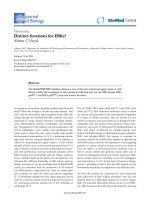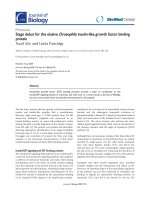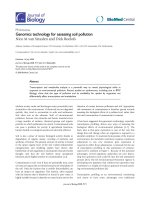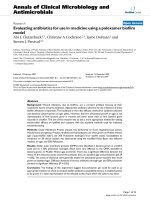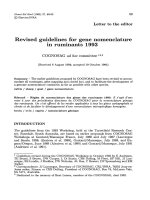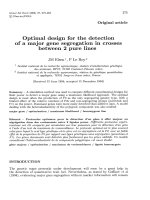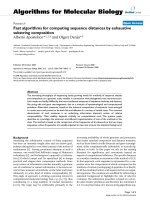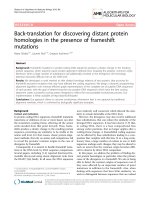Báo cáo sinh học: "Targeting TNF-α for cancer therapy" potx
Bạn đang xem bản rút gọn của tài liệu. Xem và tải ngay bản đầy đủ của tài liệu tại đây (617.18 KB, 5 trang )
Burton and Libutti: Journal of Biology 2009, 8:85
Abstract
As the tumor vasculature is a key element of the tumor stroma,
angiogenesis is the target of many cancer therapies. Recent
work published in BMC Cell Biology describes a fusion protein
that combines a peptide previously shown to home in on the
gastric cancer vasculature with the anti-tumor cytokine TNF-α,
and assesses its potential for gastric cancer therapy.
The microenvironment of any solid tumor is composed not
only of the cancer cells themselves but also of the
surrounding stromal tissue - composed of fibroblasts,
endothelial cells and pericytes of capillary walls, smooth
muscle, and immune and inflammatory cells (Figure 1).
This elaborate infrastructure is instrumental in the growth,
invasion and metastasis of a cancer. Stephen Paget, in
1889, was the first to suggest that the tumor micro-
environment might influence tumor cell behavior, with his
‘seed and soil’ hypothesis. He reported that, like seeds,
tumor cells randomly scattered throughout the vasculature
could only metastasize if they landed in ‘fertile soil’ [1].
More recently, normal stroma has been shown to inhibit
tumor growth, whereas tumor stroma encourages it. In a
study in which simian virus 40 (SV40)-transformed
normal prostate epithelial cells were grafted into mice, it
was found that cancer-associat ed fibroblasts (CAFs)
supported the tumor cells. Normal prostate cells combined
with CAFs began to take on the characteristics of
carcinogenic prostate cells, whereas normal prostate cells
combined with fibroblasts from normal tissue did not.
Likewise, prostate cells immortalized by SV40 trans-
formation grew massive tumors when combined with
CAFs, whereas there was no tumor growth in the presence
of normal fibroblasts [2].
Tumor angiogenesis
The stroma of a solid tumor is vital for its survival, and a
key component in this respect are the blood vessels. When
a tumor grows to greater than 2 to 4 mm
3
in size, it requires
new vessel growth for adequate oxygen and nutrient
delivery, and for removal of waste products [3]. The growth
of new capillaries into the tumor is called ‘tumor
angiogenesis’, a term coined by Judah Folkman in 1971.
Angiogenesis is induced by the release of various pro-
angiogenic cytokines by the tumor cells and their supporting
cells. Pro-angiogenic factors are involved in endothelial cell
proliferation and migration, the formation of endothelial
cells into new vasculature, and the degradation of the
basement membrane and the extracellular matrix by
proteolysis. Many different and functionally redundant
factors are involved in angiogenesis [4], and a list of some of
the most important is given in Table 1.
One pro-angiogenic factor highly expressed in most tumors
is vascular endothelial growth factor (VEGF) and many
VEGF and VEGF-receptor antagonists have been
developed in the search for therapeutic agents that could
prevent tumor angiogenesis. Most notably, bevacizumab, a
monoclonal antibody against VEGF, was the first
angiogenesis inhibitor proven to delay tumor growth and
significantly extend patients’ lives. It was approved by the
US Federal Drug Administration (FDA) in 2004 for first-
line use in the treatment of colorectal cancer and has since
been approved for a variety of other cancers, including
non-small cell lung cancer, metastatic HER2-negative
breast cancer, glioblastoma and metastatic renal cell
carcinoma [5].
The cytokine tumor necrosis factor (TNF-α) is also highly
expressed in tumors and is thought to be pro-angiogenic.
Paradoxically, it is also a potent anti-vascular cytokine at
higher doses (it was named for its anti-tumor activity) and
can be used clinically to destroy tumor vasculature. TNF-
alpha is able to initiate cellular apoptosis and it is possible
that these apoptotic pathways are deactivated in tumor
cells [6]. Unfortunately, TNF-α has powerful and toxic
systemic side effects and has only limited uses at present.
Much work is under way to devise ways of targeting TNF-α
specifically to tumors. In a recent paper in BMC Cell
Biology, Daiming Fan and colleagues (Chen et al. [7])
investigate one approach to targeting of TNF-α, in this case
to gastric tumors. They have fused it with a peptide known
to target the human gastric cancer vasculature and injected
the construct into the circulation of mice containing
tumors of human gastric cancer cells.
Minireview
Targeting TNF-α for cancer therapy
Elizabeth R Burton* and Steven K Libutti
†
Addresses: *Division of Gynecologic Oncology, Montefiore Medical Park, 1695 Eastchester Road, Bronx, NY 10461 USA.
†
Montefiore
Medical Center, Medical Arts Pavilion, 3400 Bainbridge Avenue, MMC-MAP, Bronx, NY 10467, USA.
Correspondence: Steven K Libutti. Email:
85.2
Burton and Libutti: Journal of Biology 2009, 8:85
The clinical potential of TNF-α
So far, TNF-α has fallen short of expectations in clinical
use as an anti-tumor agent as a result of its high systemic
toxicity at therapeutic doses. This has led to its develop-
ment as a localized therapy, as in isolated organ perfusion
for human melanoma and soft tissue sarcoma [8].
Although results are promising, with notable diminution in
systemic side effects, localized tumor perfusion is not a
reasonable option for many tumor types, especially for
widely metastatic disease. To overcome the problem,
researchers are now developing targeted TNF-α delivery
systems. These involve either direct targeting of the TNF-α
protein to the tumor and delivery by gene therapy. We
recently reported the evaluation of a potential novel gene
therapy for melanoma using a targeted adeno-associated
virus-phage (AAVP) vector to deliver TNF-α in the mouse
M21 human melanoma xenograft model. The AAVP vector
targets gene products to tumor vasculature by using an
alpha-v integrin ligand (termed RGD-4C) motif. There was
a statistically significant reduction in tumor size in mice
injected with the AAVP-TNF-α vector as compared with
controls, with no evidence of systemic toxicity [8]. A pre-
clinical trial of this treatment in 14 tumor-bearing pet dogs
by the Comparative Oncology Trials Consortium (COTC)
demonstrated safety and activity, thus paving the way for
human trials [9].
Targeting the gastric vasculature
Whereas endothelial cells lining the blood vessels of
normal tissue are quiescent, those of tumor blood vessels
express or upregulate many different markers, receptors
and antigens, such as proliferation markers, receptors for
growth factors and antigens not yet fully characterized.
Immunologic or other molecular means of targeting
therapies to endothelial cells is a reasonable approach,
therefore, as these cells are highly accessible to antibodies
or lytic effector cells [10].
Several peptides that can home to particular types of
cancer have been identified using phage-display tech-
nology, and hybrid molecules composed of peptides
conjugated to bioactive agents have shown promise in
the imaging, diagnosis and treatment of a variety of
tumors in pre-clinical and clinical trials (see references
in [7]). Homing peptides might also be used to deliver
gene therapy vectors into tumors. For example, RGD
Figure 1
Schematic of the tumor microenvironment, including tumor cells, endothelial cells, pericytes, fibroblasts, CD+ and CD- lymphocytes and
extracellular matrix components
Fibroblasts
Tumor cells
Endothelial cells
Leukocytes
Pericyte
ECM
CD4
+
T cell
CD8
+
T cell
Tumor capsule
85.3
Burton and Libutti: Journal of Biology 2009, 8:85
(Arg-Gly-Asp)-containing synthetic peptides with a high
affinity for α
v
integrins home to malignant melanomas and
breast carcinoma [11]. Peptides containing the NGR (Asn-
Gly-Arg) motif can recognize tumor neovasculature in
various tumor types [12]. The homing peptide F3, a 31
amino acid peptide in the HMGN2 sequence, homes to
HL-60 human leukemia cell xenograft tumors in vivo, and
human MDA-MB-435 breast cancer cells [13].
Fan and colleagues [14] are the first to identify a peptide
that targets human gastric cancer. In a previous study, the
group identified a novel peptide, GX-1, which binds
selectively to human gastric cancer vasculature. In their
latest paper [7] they show that, when GX-1 is fused to
recombinant mutant human TNF-α (rmh-TNF-α), the
fusion protein concentrates the TNF-α in tumors of human
gastric cancer cells grown in nude mice, delays their
growth and causes less systemic toxicity than TNF-α alone
[7]. The authors used rmh-TNF-α as it has been shown to
display greater anti-tumor activity than unmodified
TNF-α. In their current work, Chen et al. [7] also show that
GX1 can act not only as a targeting vector but also as an
anti-angiogenic agent in its own right, inhibiting the
proliferation of tumor-conditioned human umbilical vein
endothelial cells in culture by inducing apoptosis.
Endogenous inhibitors of angiogenesis
Pro-angiogenic cytokines work in concert with endogenous
angiogenesis inhibitors to regulate tumor growth in certain
locations. More than 40 endogenous angiogenesis inhibi-
tors have been discovered in humans, more than 13 of
which have been used in gene therapy models [15]
Table 1
Angiogenesis factors
Factors affecting endothelial proliferation and migration
VEGF family (vascular endothelial Mediate vascular permeability, endothelial proliferation, migration, and survival
growth factors)
FGF family (fibroblast growth factors) Have roles in neuronal signaling, inflammatory processes, hematopoiesis, angiogenesis, tumor
growth, and invasion
PDGF (platelet-derived growth factor) Induces angiogenesis, cellular proliferation and migration in synergy with transforming growth factor
beta (TGFB) and EGF
EGF (epidermal growth factor) Involved in tumor proliferation, metastasis, apoptosis, angiogenesis, and wound healing
Angiopoietins (Ang1, Ang2) Endothelial cell adhesion, spreading, focal contact formation, and migration
Angiopoietin-related growth factors For example, ANGPTL3, FARP, PGAR
TIE receptors (TIE1, TIE2) Essential in embryonic angiogenesis; endothelial motility
Eph receptors and Ephrins Promote migration, repulsion, adhesion and attachment to the extracellular matrix via integrins
HGF (hepatocyte growth factor) Neuronal survival factor; proliferation, migration and differentiation of various cell types
TP (thymidine phosphorylase) Induces endothelial chemotaxis
NPY (neuropeptide Y) Endothelial cell adhesion, migration and differentiation into capillaries
Factors affecting the basement membrane and extracellular matrix
TF (tissue factor) Upregulates VEGF on endothelial cells; starts coagulation process, leading to creation of two
pro-thrombin fragments
Thrombin Endothelial and tumor cell mitogen, increases metastasis in vivo
uPA (plasminogen activator, Only expressed in angiogenic endothelium; has a role in preventing excessive extracellular
urokinase) membrane proteolysis
tPA (tissue plasminogen activator) Role in angiogenesis, as it is inhibited by angiogenesis inhibitor angiostatin
Plasmin Scavenges α
2
-antiplasmin and α
2
-macroglobulin
Matrix metalloproteinases (MMPs) Release extracellular membrane-bound growth factors
Chymases Role in proteolysis
Heparanases Role in proteolysis
Integrins Role in attachment of endothelial cells to basement membrane, extracellular membrane, and other
endothelial cells
Multiple different and redundant factors are involved in the complex process of angiogenesis. This table represents a sample of those factors with
roles in endothelial proliferation and migration, and in the degradation of the basement membrane and extracellular matrix. Adapted from [4].
85.4
Burton and Libutti: Journal of Biology 2009, 8:85
Table 2
Endogenous angiogenesis inhibitors
Inhibitor Molecular and physiologic properties
Proteolytic fragments
Angiostatin 38-kD internal fragment of plasminogen (kringles 1–4); kringles 1–3 and kringle 5 also active.
Arrestin 26-kD carboxy-terminal noncollagenous domain of a1 chain of Type IV collagen; inhibits endothelial cell (EC)
proliferation.
Antithrombin (cleaved) 53–55-kD cleaved conformation inhibits EC proliferation and tumor growth in mice.
Canstatin 24-kD carboxy-terminal noncollagenous domain of a2 chain of Type IV collagen; inhibits EC proliferation and
apoptosis.
Endostatin 20-kD fragment of carboxy-terminal noncollagenous domain of Type XVIII collagen; mechanism of action
unknown.
Fibronectin fragments 29-kD amino-terminal and 40-kD carboxy-terminal heparin-binding fragments inhibit EC proliferation.
PEX Carboxy-terminal hemopexin-like domain of matrix metalloproteinase-2 inhibits EC proliferation and tumor
growth in mice.
Prolactin (16-kD) Naturally occurring 16-kD cleaved amino-terminal fragment of prolactin; retains activity as partial prolactin
agonist.
Prothrombin kringle-2 22-kD prothrombin fragment initially isolated from lipopolysaccharide-treated serum.
Restin 22-kD fragment of carboxy-terminal noncollagenous domain of Type XV collagen; 60% homology to murine
endostatin.
Vasostatin Amino-terminal fragment of calreticulin; inhibits EC proliferation and tumor growth in mice.
Interleukins
IL-1 17-kD β-isoform inhibits FGF-stimulated angiogenesis by an autocrine pathway.
IL-4 13-kD lymphokine; inhibits basic FGF-induced angiogenesis.
IL-10 Inhibits tumor vascularity and growth, possibly by decreasing macrophage-derived angiogenic factors.
IL-12 75-kD glycoprotein; inhibits in vivo angiogenesis via IFN-γ- and IP-10-related mechanism.
IL-18 IFN-γ-inducing cytokine; inhibits FGF-stimulated EC proliferation and in vivo angiogenesis.
Interferons
IFN-α 8 to 20-kD glycoproteins secreted by lymphocytes and phagocytes; inhibits EC proliferation and migration.
IFN-β 23-kD glycoprotein derived from fibroblasts and epithelial cells.
IFN-γ 20 to 25-kD glycoprotein secreted by T cells and natural killer cells; cytotoxic to proliferating ECs.
TIMP metallopeptidase inhibitors
TIMP-1 (TIMP metallo- Soluble 8.5-kD collagenase inhibitor.
peptidase inhibitor 1)
TIMP-2 Soluble 21-kD collagenase inhibitor.
TIMP-3 Extracellular matrix-associated collagenase inhibitor.
Other molecules
1,25-(OH)
2
-vitamin D3 Antiangiogenic effect similar to that of retinoic acid; nonhydroxylated vitamin D3 not active.
2-methoxyestradiol 0.3-kD estrogen metabolite; inhibits EC migration and urokinase plasminogen activator.
Angiopoietin-2 Inhibits angiopoietin-1-mediated activation of EC tyrosine kinase receptor, Tie2; role in vascular remodeling.
EMAP-II Tumor-derived 20-kD (34 kD proform) inflammatory cytokine.
Gro-β 8-kD CXC chemokine; inhibits tumor growth in mice.
IP-10 8.6-kD CXC chemokine induced by IFN-γ.
Maspin 42-kD serine protease inhibitor (serpin); inhibits EC migration and tumor growth and vascularity in mice.
METH-1, METH-2 110- and 98-kD proteins with metalloprotease and disintegrin-like domains, and carboxy-terminal type 1
TSP-1 repeats.
MIG 11.7-kD CXC chemokine induced by IFN-γ.
p16 Tumor supressor gene; wild type downregulates VEGF expression and inhibits angiogenesis in gliomas.
p53 Tumor suppressor gene; wild type increases TSP-1 expression, decreases VEGF expression.
PEDF 50-kD inhibitor expressed by retinal pigment epithelial cells.
Platelet factor-4 28-kD heparin-binding platelet-derived inhibitory factor.
Proliferin-related protein Inhibitor of placental angiogenesis in late gestation.
Prostate-specific antigen Serine protease associated with prostate carcinoma and other tumors.
Protamine 43-kD heparin-binding protein produced by sperm; role in vessel remodeling.
Retinoic acid 0.3-kD inhibitor of EC migration; appears to act as transcriptional regulator.
Soluble FGF receptor 60 to 85-kD circulating binding proteins that may regulate pro-angiogenic activity of FGF.
Transforming growth factor β1 25-kD inhibitor of EC growth and proteolytic activity.
Troponin I Subunit of troponin complex recently found to be present in cartilage and to inhibit angiogenesis.
TSP-1, TSP-2 450-kD platelet- and fibroblast-derived trimeric glycoproteins.
85.5
Burton and Libutti: Journal of Biology 2009, 8:85
(Table 2). Anti-angiogenic factors are not stable on their
own and they are not cytotoxic, and to be effective they
would require chronic administration. Anti-angiogenic
factors could be made more reliable through the use of
somatic gene therapy. The patient’s own cells and tissues
would be altered so as to produce increasing circulating
concentrations of the anti-angiogenic agent [15].
New approaches to cancer treatment such as drug targeting
and gene therapy hold promise for more tailored
approaches in the treatment of cancer. The more we learn
about individual cancer cells and how they function within
their microenvironment, the more therapeutic targets we
will discover. We have seen that the identification of anti-
angiogenesis targets opens up a wide new field of study.
New areas of study, together with further research in gene
therapy, will hopefully improve and prolong the lives of
patients afflicted with cancer.
References
1. Beacham DA, Cukierman E: Stromagenesis: The changing
face of fibroblastic microenvironments during tumor pro-
gression. Semin Cancer Biol 2005, 15:329-341.
2. Kalluri R, Zeisberg M: Fibroblasts in cancer. Nat Rev Cancer
2006, 6:392-401.
3. Tlsty TD, Coussens LM: Tumor stroma and regulation of
cancer development. Annu Rev Pathol Mech Dis 2006, 1:119-
150.
4. Bouis D, Kusumanto Y, Meijer C, Mulder NH, Hospers GA: A
review on pro- and anti-angiogenic factors as targets of
clinical intervention. Pharmacol Res 2006, 53:89-103.
5. National Cancer Institute [ />6. Szlosarek PW, Balkwill FR: Tumour necrosis factor α: a
potential target for the therapy of solid tumours. Lancet
Oncol 2004, 4:565-573.
7. Chen B, Shanshan C, Zhang Y, Wang X, Liu J, Hui X. Wan Y,
Du W, Wang L, Wu K, Fan D: A novel peptide (GX1) homing
to gastric cancer vasculature inhibits angiogenesis and
cooperates with TNF alpha in anti-tumor therapy. BMC Cell
Biol 2009, 10:63.
8. Tandle A, Hanna E, Lorang D, Hajitou A, Moya CA, Pasqualini
R, Arap W, Adem A, Starker E, Hewitt S, Libutti SK: Tumor
vasculature-targeted delivery of tumor necrosis factor-
alpha. Cancer 2009, 115:128-139.
9. Paoloni MC, Tandle A, Mazcko C, Hanna E, Kachala S, Leblanc
A, Newman S, Vail D, Henry C, Thamm D, Sorenmo K, Hajitou
A, Pasqualini R, Arap W, Khanna C, Libutti SK: Launching a
novel preclinical infrastructure: comparative oncology
trials consortium directed therapeutic targeting of TNF
alpha to cancer vasculature. PLoS One 2009, 4:e4972.
10. Hofmeister V, Vetter C, Schrama D, Brocker EB, Becker JC:
Tumor stroma-associated antigens for anti-cancer immu-
notherapy. Cancer Immunol Immunother 2006, 55:481-494.
11. Pasqualini R, Koivunen E, Ruoslahti E: Alpha v integrins as
receptors for tumor targeting by circulating ligands. Nat
Biotechnol 1997, 15:542-546.
12. Corti A, Curnis F, Arap W, Pasqualini R: The neovasculature
homing motif NGR: more than meets the eye. Blood 2008,
112: 2628-2635.
13. Porkk a K, Laakkonen P, Hoffman JA, Bernasconi M, Ruoslahti
E: A fragment of the HMGN2 protein homes to the nuclei of
tumor cells and tumor endothelial cells in vivo. Proc Natl
Acad Sci USA 2002, 99:7444-7449.
14. Zhiu M, Wu KC, Dong L, Hao ZM, Deng TZ, Hong L, Liang SH,
Zhao PT, Qiao TD, Wang Y, Xu X, Fan DM: Characterization
of a specific phage-displayed peptide binding to vascula-
ture of human gastric cancer. Cancer Biol Ther 2004, 3:
1232-1235.
15. Feldman AL, Libutti SK: Progress in antiangiogenic gene
therapy of cancer. Cancer 2000, 89:1181-1194.
Published: 23 October 2009
doi:10.1186/jbiol189
© 2009 BioMed Central Ltd
